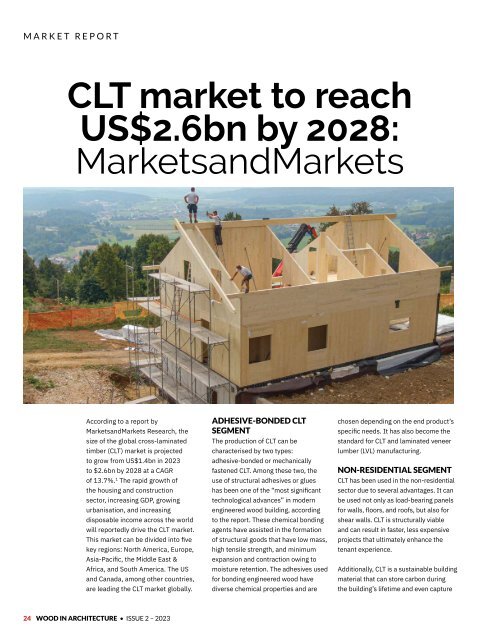WIA_ISSUE2_2023
You also want an ePaper? Increase the reach of your titles
YUMPU automatically turns print PDFs into web optimized ePapers that Google loves.
MARKET REPORT<br />
CLT market to reach<br />
US$2.6bn by 2028:<br />
MarketsandMarkets<br />
According to a report by<br />
MarketsandMarkets Research, the<br />
size of the global cross-laminated<br />
timber (CLT) market is projected<br />
to grow from US$1.4bn in <strong>2023</strong><br />
to $2.6bn by 2028 at a CAGR<br />
of 13.7%. 1 The rapid growth of<br />
the housing and construction<br />
sector, increasing GDP, growing<br />
urbanisation, and increasing<br />
disposable income across the world<br />
will reportedly drive the CLT market.<br />
This market can be divided into five<br />
key regions: North America, Europe,<br />
Asia-Pacific, the Middle East &<br />
Africa, and South America. The US<br />
and Canada, among other countries,<br />
are leading the CLT market globally.<br />
ADHESIVE-BONDED CLT<br />
SEGMENT<br />
The production of CLT can be<br />
characterised by two types:<br />
adhesive-bonded or mechanically<br />
fastened CLT. Among these two, the<br />
use of structural adhesives or glues<br />
has been one of the “most significant<br />
technological advances” in modern<br />
engineered wood building, according<br />
to the report. These chemical bonding<br />
agents have assisted in the formation<br />
of structural goods that have low mass,<br />
high tensile strength, and minimum<br />
expansion and contraction owing to<br />
moisture retention. The adhesives used<br />
for bonding engineered wood have<br />
diverse chemical properties and are<br />
chosen depending on the end product’s<br />
specific needs. It has also become the<br />
standard for CLT and laminated veneer<br />
lumber (LVL) manufacturing.<br />
NON-RESIDENTIAL SEGMENT<br />
CLT has been used in the non-residential<br />
sector due to several advantages. It can<br />
be used not only as load-bearing panels<br />
for walls, floors, and roofs, but also for<br />
shear walls. CLT is structurally viable<br />
and can result in faster, less expensive<br />
projects that ultimately enhance the<br />
tenant experience.<br />
Additionally, CLT is a sustainable building<br />
material that can store carbon during<br />
the building’s lifetime and even capture<br />
24 WOOD IN ARCHITECTURE • ISSUE 2 – <strong>2023</strong>

















